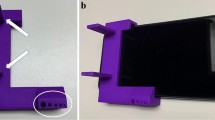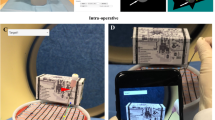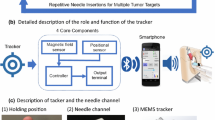Abstract
Minimally invasive surgical procedures often require needle insertion. For these procedures, efficacy greatly depends on precise needle placement. Many methods, such as optical tracking and electromagnetic tracking, have been applied to assist needle placement by tracking the real-time position information of the needle. Compared with the optical tracking method, electromagnetic tracking is more suitable for minimally invasive surgery since it has no requirement of line-of-sight. However, the devices needed for electromagnetic tracking are usually expensive, which will increase the cost of surgery. In this study, we presented a low-cost smartphone-based permanent magnet tracking method compatible with CT imaging and designed a 3D printed operation platform to assist with needle placement prior to needle insertion during minimally invasive surgery. The needle positioning accuracy of this method was tested in an open air test and a prostate phantom test in a CT environment. For these two tests, the average radial errors were 0.47 and 2.25 mm, respectively, and the standard deviations were 0.29 and 1.63, respectively. The materials and fabrication required for the presented method are inexpensive. Thus, many image-guided therapies may benefit from the presented method as a low-cost option for needle positioning prior to needle insertion.








Similar content being viewed by others
References
Abayazid, M., G. J. Vrooijink, S. Patil, R. Alterovitz, and S. Misra. Experimental evaluation of ultrasound-guided 3D needle steering in biological tissue. Int. J. Comput. Assist. Radiol. 9(6):931–939, 2014.
Abdelnasser, H., A. Khalafallah, and M. Yousef. MagController: a system for touchless mobile devices control using the magnetic field. In: 2018 IEEE International Conference on Pervasive Computing and Communications Workshops (PerCom Workshops), IEEE, 2018, pp. 300–305.
Abdelnasser, H., M. Youssef, and K. A. Harras. Magboard: magnetic-based ubiquitous homomorphic off-the-shelf keyboard. In: 2016 13th Annual IEEE International Conference on Sensing, Communication, and Networking (SECON), IEEE, 2016, pp. 1–9.
Abe, T., B. Shizuki, and J. Tanaka. Input techniques to the surface around a smartphone using a magnet attached on a stylus. In: Proceedings of the 2016 CHI Conference Extended Abstracts on Human Factors in Computing Systems, ACM, 2016, pp. 2395–2402.
Black, P. M., T. Moriarty, E. Alexander, P. Stieg, E. J. Woodard, P. L. Gleason, C. H. Martin, R. Kikinis, R. B. Schwartz, and F. A. Jokesz. Development and implementation of intraoperative magnetic resonance imaging and its neurosurgical applications. Neurosurgery 41(4):831–845, 1997.
Chen, K.-Y., K. Lyons, S. White, and S. Patel. uTrack: 3D input using two magnetic sensors. In: Proceedings of the 26th Annual ACM Symposium on User Interface Software and Technology, ACM, 2013, pp. 237–244.
Cheung, V., and A. Girouard. Exploring around-device tangible interactions for mobile devices with a magnetic ring. In: Proceedings of the Twelfth International Conference on Tangible, Embedded, and Embodied Interaction, ACM, 2018, pp. 108–114.
Chow, T. L. Introduction to Electromagnetic Theory: A Modern Perspective. Burlington: Jones & Bartlett Learning, 2006.
Civco. Disposable Template Grids. Civco Medical Solutions.
Franz, A. M., T. Haidegger, W. Birkfellner, K. Cleary, T. M. Peters, and L. Maier-Hein. Electromagnetic tracking in medicine—a review of technology, validation, and applications. IEEE Trans. Med. Imaging 33(8):1702–1725, 2014.
Gergel, I., J. Hering, R. Tetzlaff, H. P. Meinzer, and I. Wegner. An electromagnetic navigation system for transbronchial interventions with a novel approach to respiratory motion compensation. Med. Phys. 38(12):6742–6753, 2011.
Han, X., H. Seki, Y. Kamiya, and M. Hikizu. Wearable handwriting input device using magnetic field: geomagnetism cancellation in position calculation. Precis. Eng. 33(1):37–43, 2009.
Henken, K. R., J. Dankelman, J. J. van den Dobbelsteen, L. K. Cheng, and M. S. van der Heiden. Error analysis of FBG-based shape sensors for medical needle tracking. IEEE/ASME Trans. Mechatron. 19(5):1523–1531, 2014.
Hwang, S., M. Ahn, and K.-Y. Wohn. MagGetz: customizable passive tangible controllers on and around conventional mobile devices. In: Proceedings of the 26th Annual ACM Symposium on User Interface Software and Technology, ACM, 2013, pp. 411–416.
Kelly, A. A 3D state space formulation of a navigation Kalman filter for autonomous vehicles. Pittsburgh PA: Carnegie Mellon University, Robotics Institute, 1994.
Kochavi, E., D. Goldsher, and H. Azhari. Method for rapid MRI needle tracking. Magn. Reson. Med. 51(5):1083–1087, 2004.
Krücker, J., S. Xu, N. Glossop, A. Viswanathan, J. Borgert, and H. Schulz. Electromagnetic tracking for thermal ablation and biopsy guidance: clinical evaluation of spatial accuracy. J. Vasc. Interv. Radiol. 18(9):1141–1150, 2007.
Li, R., S. Xu, I. Bakhutashvili, I. B. Turkbey, P. Choyke, P. Pinto, B. Wood, and T. H. Zion. Template for MR visualization and needle targeting. Ann. Biomed. Eng. 47(2):524–536, 2019.
Pourtaherian, A., S. Zinger, P. de With, H. H. Korsten, and N. Mihajlovic. Gabor-based needle detection and tracking in three-dimensional ultrasound data volumes. In: 2014 IEEE International Conference on Image Processing (ICIP), IEEE, 2014, pp. 3602–3606.
Reid, I., and H. Term. Estimation II. www.robots.ox.ac.uk. Oxford University. Retrieved 6 August 2014.
Tilak, G., K. Tuncali, S. E. Song, J. Tokuda, O. Olubiyi, F. Fennessy, A. Fedorov, T. Penzkofer, C. Tempany, and N. Hata. 3T MR-guided in-bore transperineal prostate biopsy: a comparison of robotic and manual needle-guidance templates. J. Magn. Reason. Imaging 42(1):63–71, 2015.
Tokuda, J., K. Tuncali, I. Iordachita, S. Song, A. Fedorov, S. Oguro, A. Lassó, F. Fennessy, Y. Tang, C. Tempany, and N. Hata. Preliminary accuracy evaluation of 3T MRI-guided transperineal prostate biopsy with grid template. In: 19th Annual Meeting and Exhibition, International Society of Magnetic Resonance in Medicine. Proceedings of the International Society for Magnetic Resonance in Medicine, 2011, vol. 19, p. 3761.
Vrooijink, G. J., M. Abayazid, and S. Misra, Real-time three-dimensional flexible needle tracking using two-dimensional ultrasound. In: 2013 IEEE International Conference on Robotics and Automation (ICRA), IEEE, 2013, pp. 1688–1693IEEE.
Yoon, S. H., K. Huo, and K. Ramani. TMotion: embedded 3D mobile input using magnetic sensing technique. In: Proceedings of the TEI’16: Tenth International Conference on Tangible, Embedded, and Embodied Interaction, ACM, 2016, pp. 21–29.
Zhao, Z, Z. T. Tse. A smartphone and permanent magnet-based needle guidance system. In: 2019 International Symposium on Medical Robotics (ISMR), IEEE, 3 Apr 2019, pp. 1–5.
Acknowledgments
This study was supported in part by the National Institutes of Health (NIH) Bench-to-Bedside Award, the NIH Center for Interventional Oncology Grant, the National Science Foundation (NSF) I-Corps Team Grant (1617340), NSF REU site program 1359095, the UGA-AU Inter-Institutional Seed Funding, the American Society for Quality Dr. Richard J. Schlesinger Grant, the PHS Grant UL1TR000454 from the Clinical and Translational Science Award Program, and the NIH National Center for Advancing Translational Sciences, the NIH Center for Interventional Oncology: Grant ZID# BC011242 & CL040015 and supported by the Intramural Research Program of the National Institutes of Health.
Author information
Authors and Affiliations
Corresponding author
Additional information
Associate Editor Sean S. Kohles oversaw the review of this article.
Publisher's Note
Springer Nature remains neutral with regard to jurisdictional claims in published maps and institutional affiliations.
Rights and permissions
About this article
Cite this article
Zhao, Z., Xu, S., Wood, B.J. et al. The Feasibility of Using a Smartphone Magnetometer for Assisting Needle Placement. Ann Biomed Eng 48, 1147–1156 (2020). https://doi.org/10.1007/s10439-019-02436-5
Received:
Accepted:
Published:
Issue Date:
DOI: https://doi.org/10.1007/s10439-019-02436-5




